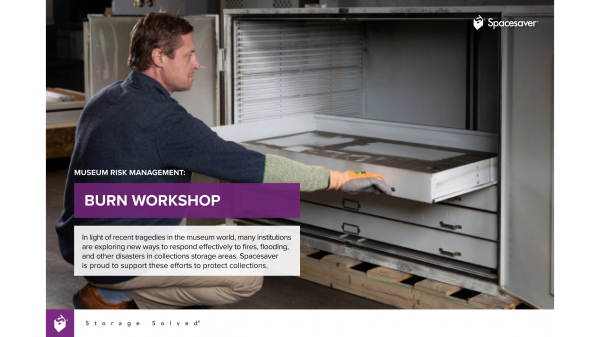Spacesaver (800.255.8170), a US-based manufacturer of storage equipment, has released a new guide to agents of deterioration and the best storage practices for preserving historical relics.

—
The company’s latest guide is intended for historical institutions looking to prevent irreparable damage to valuable artifacts. By informing readers of common agents of deterioration, Spacesaver aims to help them take the necessary precautions to protect their collections.
For more information, please visit https://www.spacesaver.com/blog/museum-collection-care-best-practices
Spacesaver’s guide cites ten agents of deterioration as the most devastating of potential threats, and these have all been verified by industry professionals. The first of them is direct physical force, such as sudden shock, vibrations, or pressure, which can break and deform objects. Some causes of direct physical force include system operations and seismic activity. Spacesaver recommends installing anti-tip rail systems and bars for stability on mobile systems and attaching cabinets to one another for added stability to mitigate damage.
Pollutants are another common threat, and these can range from dirt, volatile compounds, and residual pesticides that are either airborne or transferred by touch. To protect their collections, institutions can seal them in cabinets made with non-gassing paint. Spacesaver manufactures such products, offering airtight museum cabinets that feature fumigant-resistant elastomeric gaskets and three-point latches that shield fragile items from contaminants.
Sealed museum cabinets will also protect relics from fire, smoke, and soot, which are less common but extremely damaging agents of deterioration, the guide says. For water damage and flooding, Spacesaver instead advises institutions to use metal storage, steel compactors that can raise shelving four to six inches off the ground, and cabinets with waterproof caps. Elevated storage spaces will also reduce the amount of habitable environments for pests and mold, both of which are threats to organic artifacts.
Other agents of deterioration include incorrect storage temperature and humidity, radiation, and thieves and vandals. These can be addressed with airtight storage equipment of the appropriate size, functioning HVAC systems, UV protection, and the proper locking mechanisms, respectively. Finally, Spacesaver notes that neglect can often lead to damage and loss of items, making it important for institutions to organize and maintain their collections to ensure they are adequately preserved.
Interested parties can read the full guide at https://www.spacesaver.com/blog/museum-collection-care-best-practices
Contact Info:
Name: Laura Walton
Email: Send Email
Organization: Spacesaver Corporation
Address: 1450 Janesville Avenue, Fort Atkinson, Wisconsin 53538, United States
Phone: +1-800-255-8170
Website: https://www.spacesaver.com/
Source: PressCable
Release ID: 89138595
If there are any deficiencies, discrepancies, or concerns regarding the information presented in this press release, we kindly request that you promptly inform us by contacting error@releasecontact.com (it is important to note that this email is the authorized channel for such matters, sending multiple emails to multiple addresses does not necessarily help expedite your request). Our dedicated team is committed to addressing any identified issues within 8 hours to guarantee the delivery of accurate and reliable content to our esteemed readers.
